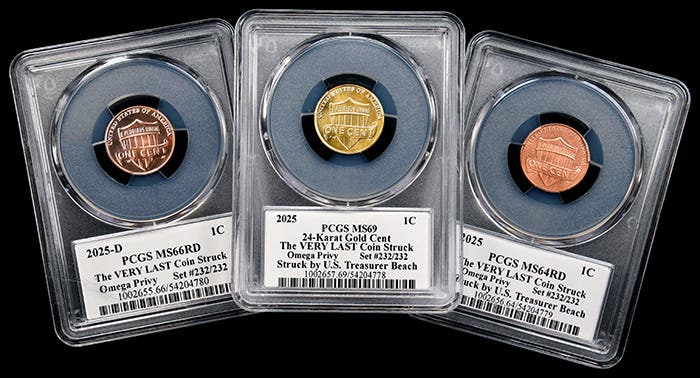What’s the Best Buy in Bullion-Priced Gold?
There are several factors to consider, but in general, bullion-priced coins that have been manufactured for a long time or are no longer in production will often sell closer to metal value than newer products.
After researching the concept and reaching the decision that they should own some bullion-priced gold, people are often surprised to learn that there are a number of options available to purchase.
Once someone realizes that there are a variety of options, their next question is invariably, “What’s the best one to buy?”
Where I work, our general answer is to suggest products trading at the lowest premiums above their metal value, as long as they are forms that are highly liquid. One reason for this advice is that lower-premium products often have tighter buy/sell spreads than do higher-premium items.
Factors to consider
Still, the answer to what is the best buy in bullion-priced gold can be different from one person to the next. Here are some factors to consider in judging what best suits each buyer:
• Some people in America are most comfortable with U.S.-made coins and ingots. Others specifically want to avoid American issues. To some, this distinction doesn’t matter.
• Would a buyer prefer a coin or ingot with even weights stated in troy ounces or grams? Many buyers are instead attracted to older gold coins that actually entered circulation, none of which are exact weights of gold content. Examples of these older alloyed coins are British sovereigns; Belgian, French and Swiss 20 francs; Dutch 10 guilders; Austrian 1 and 4 ducats and 100 coronas; Mexico 2 pesos through 50 pesos; Russian 5 and 10 rubles; and Italy 20 lire. Even some circulated pre-1934 U.S. gold coins can sometimes trade close enough to metal value to be considered bullion-priced.
• Does it matter whether the coins or ingots are pure 24-karat gold or alloyed? Pure gold choices are popular in Asia, but pure gold has the disadvantage of being a soft metal. We have had customers drop a pure gold Maple Leaf coin a few inches onto the counter in our showroom, where the coin dented. Alloyed coins, in contrast, are more durable. But, in a market where gold coins and ingots are being melted en masse, pure gold forms might be worth 1-2 percent more than alloyed issues.
• Some buyers prefer owing ingots, but they can result in duties being charged if carried across national borders. Other buyers would rather own legal tender coinage.
• Most gold coins, medallions and ingots are readily liquid at most coin dealerships. But, something to consider is possible scenarios where gold might be bartered with other people. In such circumstances, the most widely traded forms would be easier to trade.
• Divisibility is also a consideration. Smaller-sized coins and ingots might be more desirable, but the trade-off is that they tend to sell at higher premiums above their metal value.
• Although five states have no sales taxes at all (Alaska*, Delaware, Montana, New Hampshire and Oregon) and 35 other states have partial or complete sales tax exemptions on purchases of gold in coin or ingot form, several states have different definitions of what qualifies for exemption from sales tax. It is best for a buyer to check which items are exempt from sales tax where they live.
• Some buyers prefer to avoid the purchase of the forms of gold where the dealer who may someday buy it from them might be required to report that transaction to the Internal Revenue Service on Form 1099-B.
It can also happen that relative premium levels can change over time. So, whatever a buyer deems to be the “best buy” at one time may not necessarily be the best choice in the future.
In general, bullion-priced coins that have been manufactured for a long time, or are no longer in production, will often sell closer to metal value than newer products. The typical trend for newer bullion-priced coins is that their buy and sell prices relative to metal value will both tend to decline in the future. Coins where retail premiums have already declined, such as the Austria 100 coronas and Mexico 50 pesos, have less risk of a falling premium relative to metal value than to issues in current production.
There are also buyers who approach owning bullion-priced gold as a collection. They seek out different coins and ingots, even in different sizes, so long as they are priced on the basis of metal value.
Consider that all of these factors can add to the appreciation of owning bullion-priced physical gold rather than as an intimidating obstacle to overcome.
By the way, these same factors also come into play when deciding which physical forms of silver, platinum and palladium to acquire.
*Note that some municipalities in Alaska impose a local sales tax.
Patrick A. Heller was honored as a 2019 FUN Numismatic Ambassador. He is also the recipient of the American Numismatic Association 2018 Glenn Smedley Memorial Service Award, 2017 Exemplary Service Award, 2012 Harry Forman National Dealer of the Year Award and 2008 Presidential Award. Over the years, he has also been honored by the Numismatic Literary Guild (including in 2021 for Best Investment Newsletter), Professional Numismatists Guild, Industry Council for Tangible Assets and the Michigan State Numismatic Society. He is the communications officer of Liberty Coin Service in Lansing, Mich., and writes Liberty’s Outlook, a monthly newsletter on rare coins and precious metals subjects. Past newsletter issues can be viewed at www.libertycoinservice.com. Some of his radio commentaries titled “Things You ‘Know’ That Just Aren’t So, And Important News You Need To Know” can be heard at 8:45 a.m. Wednesday and Friday mornings on 1320-AM WILS in Lansing (which streams live and becomes part of the audio archives posted at www.1320wils.com).









